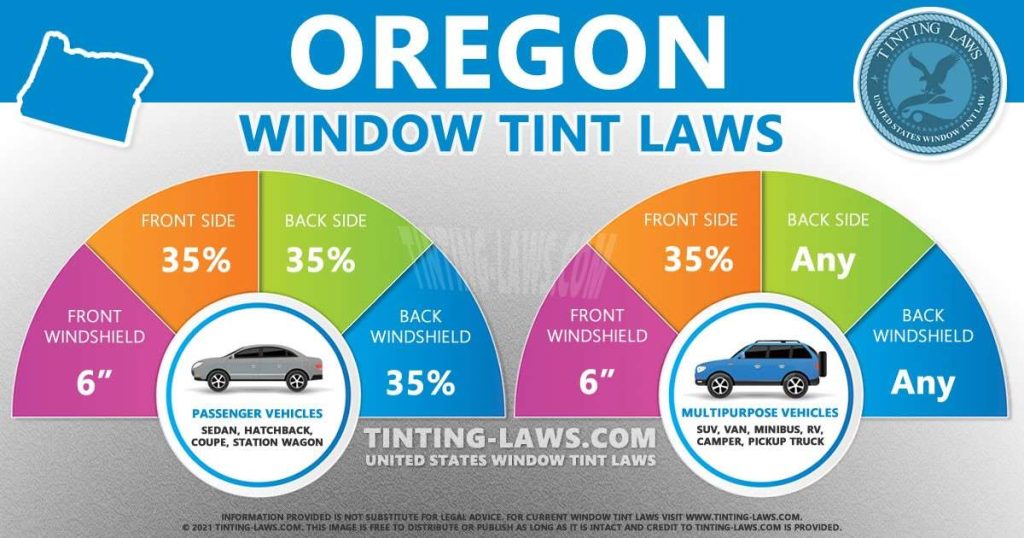Oregon Window Tinting Laws
Car window tinting laws in Oregon were enacted in 2003.
We have provided all the necessary information about your car’s window tint, including how dark or reflective the tint is allowed in your state.
There are also additional car window tinting rules and regulations in Oregon so make sure you read all about it below.
Window tint darkness in Oregon
The percent of visible light allowed through your car windows is called VLT: Visible Light Transmission.
The percentage of light allowed through your film and glass in Oregon is very specific and different for sedan cars and SUV cars or vans.
Tint darkness for sedans:
- Windshield: Non-reflective tint is allowed on the top 6 inches of the windshield.
- Front Side windows: Must allow more than 35% of light in.
- Back Side windows: Must allow more than 35% of light in.
- Rear Window: Must allow more than 35% of light in.
Tint darkness for SUV and vans:
- Windshield: Non-reflective tint is allowed on the top 6 inches of the windshield.
- Front Side windows: Must allow more than 35% of light in.
- Back Side windows: Any darkness can be used.
- Rear Window: Any darkness can be used.
Window tint reflection in Oregon
Window tint can reflect incoming light and reduce glare and heat.
Oregon window tint law permits a certain window reflection when using a tint so make sure you pay attention to this as well.
Tint reflection for sedans:
- Front Side windows: Must not be more than 13% reflective.
- Back Side windows: Must not be more than 13% reflective.
Tint reflection for SUV and vans:
- Front Side windows: Must not be more than 13% reflective.
- Back Side windows: Must not be more than 13% reflective.
Other Oregon window tint rules and regulations:
Oregon does have several other important laws, rules and regulations pertaining to window tinting. They include the following:
- Side Mirrors: If any window behind driver is tinted dual side mirrors are required.
- Restricted Colors: Red, gold, yellow, amber or black tint colors are not permitted by law.
- Certificates: Tint installers must provide you with a certificate stating light transmittance and reflectance.
- Stickers: No sticker to identify legal tinting is required by law.
- Medical Exceptions: Oregon allows medical exemptions for darker tint.
- Penalties: Class B traffic violation with $360 fine.
Keep in mind that Oregon tinting laws and regulations may be interpreted differently in your county or place of residence.
We always recommend double-checking our information with your local DMV or law enforcement authorities.

Our information about window tint laws in Oregon was last updated in 2024.
Tinting laws in Oregon were enacted in 2003.
In case any of our info provided is not up to date or correct be sure to contact us so we can fix it. Thanks!
Trusted industry leader in providing accurate window tint laws. Share with confidence:
State of Oregon Info
Oregon is a state in the Pacific Northwest region of the United States.
It is located on the Pacific coast, with Washington to the north, California to the south, Nevada on the southeast and Idaho to the east.

The Columbia and Snake rivers delineate much of Oregon’s northern and eastern boundaries, respectively.
Oregon is the 9th most expansive and the 27th most populous of the 50 United States.
Salem is the state’s capital and third-most-populous city; Portland is the most populous.
Portland is the 29th-largest U.S. city, with a population of 603,106 (2012 estimate) and a metro population of 2,262,605 (2011 estimate), the 23rd-largest U.S. metro area.
Capital: Salem
Population: 4,246,155
Area: 98,381 sq mi (255,026 km2)
Cities in Oregon: Portland, Bend, Eugene, Salem, Beaverton, Corvallis, Medford, Hillsboro, Ashland, Lake Oswego, Grants Pass, Coos Bay, Klamath Falls, Oregon City, Newport, Astoria, Seaside, Lincoln City, Cannon Beach, Gresham, Tigard, Roseburg, McMinnville, Fossil, Brookings, The Dalles, Hood River, Albany, Florence, Springfield, Redmond, Milwaukie, La Grande, Pendleton, Bandon, Newberg, Tualatin, Sherwood, Wilsonville, West Linn, Helix, Sisters, Boring, Baker City, Power City, Forest Grove, Tillamook, Prineville, Minam, Hermiston
Counties in Oregon: Baker, Benton, Clackamas, Clatsop, Columbia, Coos, Crook, Curry, Deschutes, Douglas, Gilliam, Grant, Harney, Hood River, Jackson, Jefferson, Josephine, Klamath, Lake, Lane, Lincoln, Linn, Malheur, Marion, Morrow, Multnomah, Polk, Sherman, Tillamook, Umatilla, Union, Wallowa, Wasco, Washington, Wheeler, Yamhill
Tint law references:
Oregon Department of Transportation: Frequently asked questions about window tinting (.pdf file)
Oregon Department of Transportation: Vehicle Equipment Standards (see under FAQ – Windows)